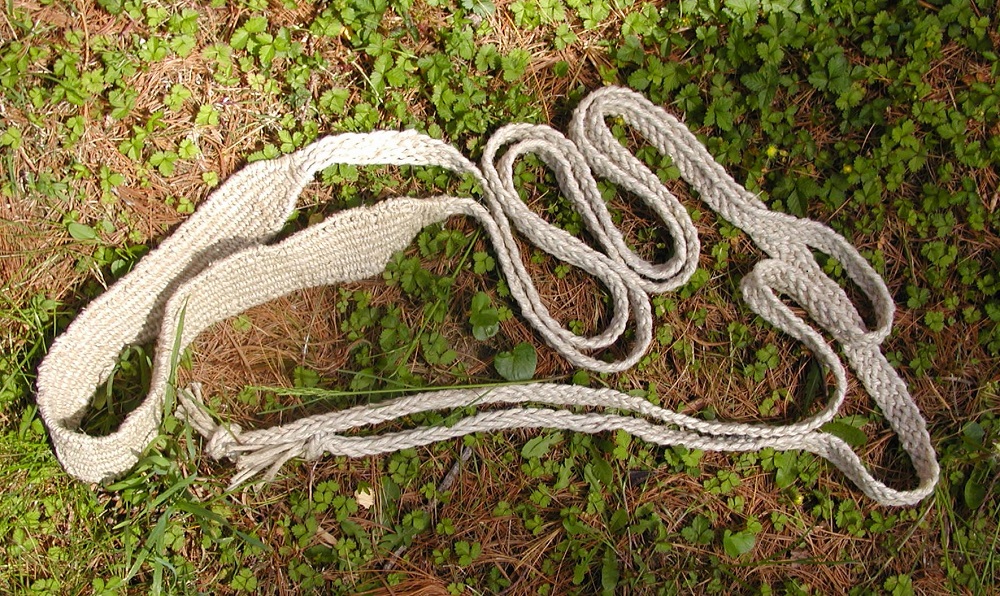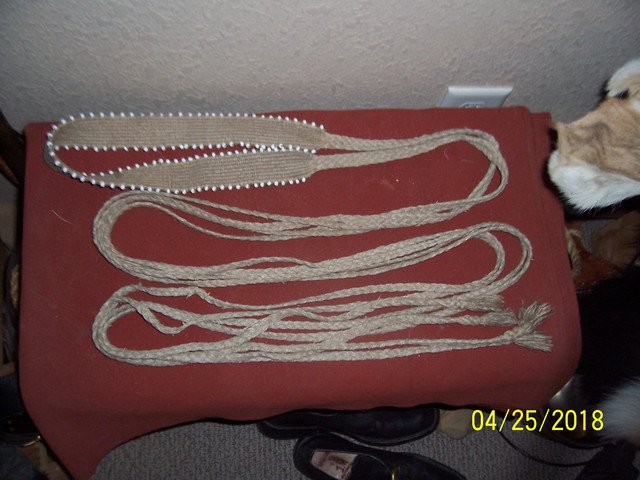I made this three or four weeks ago, but only took pictures recently and got them off the camera today. I usually don't post my own handiwork on this forum, but since a lot of the inspiration came from this thread: Tumpline?, I thought I'd make an exception. Some of you might find this interesting.

Here are the basic stats: The warp is 8 strands of 170 pound hemp cord from Hemp Basics (about 1/8" thick), about 20 long, and the weft is Cousin's medium weight hemp (approximately 1/16" thick) that Wal-Mart sells. It is twined in the center section, finger woven with the oblique weave for the straps, with the ends braided in an 8-strand box braid.
The center section is roughly 2 1/4" wide, the straps roughly an inch, and while I haven't stretched it out and got an exact length it is just about 15 feet long overall. Those are pretty typical dimensions for surviving examples from the Eastern Woodlands and what I was shooting for, so I'm pretty pleased.
One reason I'm giving all these details is because most instructions on the 'net omit dimensions. I've been thinking about making one of these for at least a year and a half, but was kind of paralyzed by not having any idea how much cord I was going to need. I won't go through all the different calculations that turned out to be wrong, but I will say that I ended up using about half the amount of amount of warp cord I expected to use. Since I was ordering online and the initial cost of shipping is pretty stiff, it made more sense to me to order a lot, enough for several tries and some experimentation, rather than risk having to order again and pay 12 bucks to get a 6 dollar ball of cord shipped when I cam up just a hair short...Only problem with this idea is that I now have 1100+ feet of cord for future projects. I think I can live with that kind of mistake.
Anyway, this was a lot easier to do than I expected, and while the end product is pretty rough looking it is perfectly serviceable.

Here are the basic stats: The warp is 8 strands of 170 pound hemp cord from Hemp Basics (about 1/8" thick), about 20 long, and the weft is Cousin's medium weight hemp (approximately 1/16" thick) that Wal-Mart sells. It is twined in the center section, finger woven with the oblique weave for the straps, with the ends braided in an 8-strand box braid.
The center section is roughly 2 1/4" wide, the straps roughly an inch, and while I haven't stretched it out and got an exact length it is just about 15 feet long overall. Those are pretty typical dimensions for surviving examples from the Eastern Woodlands and what I was shooting for, so I'm pretty pleased.
One reason I'm giving all these details is because most instructions on the 'net omit dimensions. I've been thinking about making one of these for at least a year and a half, but was kind of paralyzed by not having any idea how much cord I was going to need. I won't go through all the different calculations that turned out to be wrong, but I will say that I ended up using about half the amount of amount of warp cord I expected to use. Since I was ordering online and the initial cost of shipping is pretty stiff, it made more sense to me to order a lot, enough for several tries and some experimentation, rather than risk having to order again and pay 12 bucks to get a 6 dollar ball of cord shipped when I cam up just a hair short...Only problem with this idea is that I now have 1100+ feet of cord for future projects. I think I can live with that kind of mistake.
Anyway, this was a lot easier to do than I expected, and while the end product is pretty rough looking it is perfectly serviceable.







